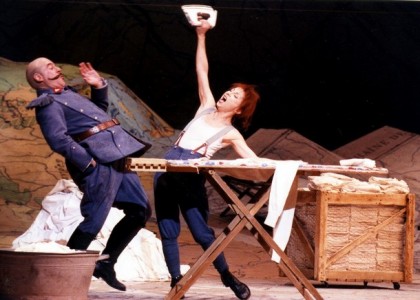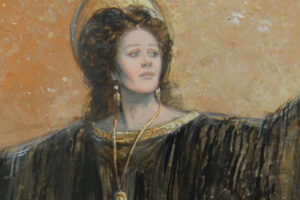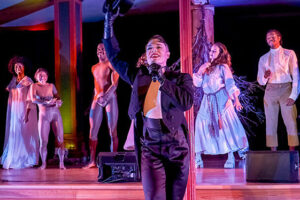
[Our Own Gualtier Maldè reports from this afternoon’s dress rehearsal of La Fille du Régiment]
The Met has another hit on its hands — though not a totally new one, this production and cast already having triumphed at Covent Garden and the Vienna Staatsoper.
Laurent Pelly (who vies with Davide Alagna and Mark Streshinsky as cutest director working in opera today) has put together a show whose ensemble works better (thanks to the superb cast) than the problematic individual production pieces. The setting is moved forward to sometime in the early twentieth century – probably World War I era. This is not a problem since the social and political mores of the piece work just as well in this setting.
The sets by Chantal Thomas consist of war maps from the Napoleonic era built up and spread across the stage to resemble hills, valley and alps. A surreal cut-out chateau interior is placed upon this for the Birkenfield castle in Act II. The set design looked dreary and cluttered in the set model maquettes on display at the Met. On the Met stage they looked bright, spare but rather flat in a surreal disorienting way rather like the Cesare Lievi La Cenerentola production. Like the piece itself, the sets would work more charmingly in a smaller theater. The second act works much better than the first in toto.
The dialogues have been entirely rewritten by Agathe Mélinand, a frequent Pelly collaborator in updating Offenbach librettos. In the post-production interview, the petite blonde Mélinand mentioned that once she knew Natalie Dessay was to be the heroine, she wrote without inhibition or fear knowing that this multitalent could handle any dramatic demands thrown at her. Indeed it is hard to imagine this production without Dessay. Very much the tomboy with a Pippi Longstocking reddish wig and wearing suspender trousers and a man’s undershirt in the first act, Dessay is a comedic marvel.
A whirling dervish of physical energy (some found her performance oversold and undersung), Dessay managed to seem equally comfortable in rapid fire spoken dialogue and rapid fire coloratura, both punctuated by bravura comic pratfalls and slapstick. Lucille Ball, Gilda Radner, Giulietta Masina and Charlie Chaplin came to mind at various points. Many roulades and cadenzas were physicalized with precisely coordinated comic business. Hyperkinetic and dominating, there is a true comedienne there.
Her singing by and large was very good though her voice is small and the tone can get thready and spread in tone. The sopracuti can only be reached with a sort of pitched scream. The audience was more moved and excited by her delicate, floated and deeply felt “Il Faut Partir” than by previous or subsequent fireworks.
Similarly, Juan Diego Florez melted the audience into pools on the floor with his “Pour me rapprocher de Marie” in the second act though he hit all the high C’s with panache in his Act I scena “O mes amis, quel jour de fete . . . Pour mon ame”. His voice doesn’t quite have the brilliant punch on top and the high C’s are lightly and accurately struck rather than batted out of the park, Pavarotti style. The nasality in his tone works fine in tandem with the French language. The voice is also small but very focused at all times. His total command of his person and his voice carries all before him. Florez and Dessay are well-matched as a team, both small and slender, very agile physically and vocally, charming and energetic. They seem made for each other onstage. He wears knee socks and lederhosen in the first act and a smart uniform in Act II.
Alessandro Corbelli is a droll comedian as Sulpice but his voice sounded dry and half-parlando this afternoon which was a rehearsal. He is padded in the middle and wears walrus-like whiskers and is fitted out with a bald wig. Felicity Palmer as the Marquise acts with style and point, big-scaled but never crossing the line into vulgarity and camp. She also sings well with superb French pronunciation and diction – her lean but resonantly pointed tone adding clarity to her delivery. Veteran British baritone Donald Maxwell is a superbly befuddled Hortensius who makes the role more than the throwaway buffoon usually seen. (Note to Krunoslav: perhaps you hadn’t noticed this and are too tactful to our U.K. commenters to mention it but Maxwell is a totally unnecessary British import – do you think Jonathan Friend and Sally Billingshurst were perhaps catering to old agent buddies across the pond in hiring him???).
Marian Seldes unlike Beatrice Arthur or Montserrat Caballé was not directed to stop the show for a vaudeville turn as the Duchesse de Krakenthorp. For the most part speaking Mélinand’s dialogue in French (pretty good if not echt) and occasionally throwing in the odd phrase in English (notably a direction to the Marquise concerning liquid refreshments), Seldes played the aristocratic dragon lady to the hilt and didn’t miss a laugh but without stepping outside the framework of the production or seeming to be a visitor from another artistic planet. We need to see her Lady Bracknell before it is too late. Fans of Queer as Folk will recognize Canadian actor Jack Wetherall (“Vic Grassi”) who plays the bit part of the Notary in Act II. He also will be remembered for the nude bath he took as a sexy chauffeur in the environmental play Tamara off-Broadway twenty years ago.
Marco Armiliato‘s conducting was energetic and fast but I found it lacking in detail and thus lacking some sparkle as well. The singers and orchestra seem very comfortable with him. Everything seemed to go smoothly with this well-traveled cast and there were no stops and no corrections – barely any musical notes after the curtain came down.
The first act had some decided longeurs where despite good acting from Dessay the dramatic energy and momentum lagged during the some long dialogue scenes. I think that cues need to be picked up faster here and the pace quickened. The second act however has brilliant bits including the climactic confrontation between the Marquise’s party guests and Marie’s regiment (no spoilers here but it involves a prop not seen before on the Met stage).
All in all, a very good vehicle for the stars and a production that is not totally a success but shows them off well. How it will work for Diana Damrau later on in revival is hard to guess. This open house was more like the usual dress rehearsal event except for the presence of video cameras rehearsing for the HD broadcast two Saturdays from now. There was no free lunch sponsored by Agnes Varis and no previews of HD presentations in List Hall. Only some demonstrations of lighting equipment and costume designs on the Grand Tier level during intermission. The audience seemed incredibly enthusiastic, especially about the personable leading couple who got a standing ovation at the final curtain call.
The post production interview with Margaret Juntwait had mostly predictable questions and answers. Dessay mentioned that doing hyperkinetic physical stunts not only doesn’t hinder but may help her singing by taking the concentration and nervous tension off of her voice production – the movements free the voice.
Florez mentioned that such vocal and physical freedom can only be achieved with much rehearsal which they had in London and were able to polish in New York at the Met. He also coined a new English verb “contaged” as in “made contagious” indicating that he found Mlle. Dessay’s comic spirit infectious. Pelly reiterated in French the ancient directorial direction that one can only achieve true comedy by stressing the serious realities underpinning the situations.
Felicity Palmer discussed intelligently that though she used a character voice in speaking in singing she used her real voice but used the text to give specific color and character without distorting the tone. Marian Seldes said that this cast included some of the best actors she has ever worked with and just wanted to say that this production was a dream all around. She wisely sidestepped any issues of coming in late in the rehearsal period replacing (superbly) another distinguished actress. Ms. Seldes seemed to have a warm rapport with her new operatic colleagues.
All tickets are sold out for the entire run except for standing room and rush tickets sold on the day of the performance. Despite being available on video elsewhere and coming soon to a movie theater near you and later to public television, this is definitely worth a look and a listen in the house.
























Comments